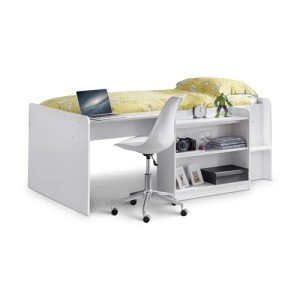The Hidden Secrets Of Bunk Beds Sale
Bunk Beds Sale: A Comprehensive Guide to Choosing the Right Bunk Bed for Your Home
Bunk beds have actually long been a staple in kids's bedrooms, offering a combination of space-saving performance and fun. Whether accommodating siblings, pals on pajama parties, or merely optimizing a playroom, bunk beds have ended up being a necessary aspect in modern-day household homes. As sales on bunk beds rise, it ends up being significantly vital for consumers to make informed choices when buying one. This short article will cover the basics of purchasing a bunk bed, from types to security functions, in addition to pointers for maintaining the stability of your financial investment.
Types of Bunk Beds
When considering a bunk bed sale, it's crucial to understand the different styles offered on the marketplace. Below are the most typical types:
Traditional Bunk Beds: These include two beds stacked one above the other, sharing a single frame. They are often the most affordable option.
L-Shaped Bunk Beds: This design includes one bed placed vertically and another horizontally. This plan develops extra space underneath the upper bed, which can be used for storage or a play location.
Lofted Beds: Similar to conventional bunk beds however without any lower bed. Rather, the space below can be used for a desk, play location, or extra storage.
Triple Bunk Beds: For households with a larger variety of children or regular pajama parties, triple bunk beds offer 3 sleeping areas in a space-efficient style.
Futon Bunk Beds: These designs combine bunk beds and futon couches. The bottom section transforms into a separate seating area, boosting performance.
Convertible Bunk Beds: These beds can be separated into two specific beds, making them flexible as kids's requirements change gradually.
Table 1: Comparison of Bunk Bed Types
Type
Description
Space Efficiency
Additional Features
Standard Bunk Bed
2 beds stacked vertically
High
Simplest style
L-Shaped Bunk Bed
One vertical and one horizontal bed
Moderate
Play or storage space
Lofted Bed
Elevated bed with open space below
High
Work/play location
Triple Bunk Bed
3 stacked beds
Extremely High
Accommodates more users
Futon Bunk Bed
Bunk bed with a convertible futon
High
Multi-functional
Convertible Bunk Bed
Can be split into two separate beds
Moderate
Versatility & & durability
Security Features to Consider
Safety is paramount when purchasing a bunk bed. Below are key safety functions to try to find:
Guardrails: Adequate guardrails need to be present on both sides of the upper bunk to prevent falls. Toddler Bunk Beds ought to be at least 5 inches greater than the bed mattress.
Ladder Design: Look for durable, broad ladders with slip-resistant rungs. Make sure that the angle is not too high for simple gain access to.
Stability: Ensure the bed is built with strong products, such as strong wood or heavy-duty metal. breaking news must not wobble when in use.
Weight Limit: Check the weight capability of the bunk bed to ensure it can accommodate the intended users safely.
Product Safety: If possible, choose beds made from non-toxic materials or those fulfilling security standards for children's furnishings.
Table 2: Essential Safety Features
Function
Description
Value
Guardrails
Sides of upper bed to prevent falls
Necessary for child security
Ladder Design
Solid, slip-resistant rungs
Help safe and easy gain access to
Stability
Construct quality to avoid wobbling
Ensures security and durability
Weight Limit
Optimum weight capacity
Prevents mishaps
Material Safety
Non-toxic, safe materials
Protects children's health
Maintenance Tips for Bunk Beds
To extend the life of your bunk bed and ensure ongoing security, think about the following maintenance suggestions:
Regular Inspections: Periodically inspect the structure for loose screws, bolts, or any indications of wear. Tighten fasteners as necessary.
Tidy Periodically: Dust and tidy the surface areas frequently. Usage appropriate cleaners that won't harm the finish.
Examine Weight Limits: Be mindful of weight limits, especially with older kids or adults who may want to use the upper bunk.
Avoid Climbing on Guardrails: Educate children not to use guardrails for climbing or playing to lower the danger of accidents.
Often Asked Questions (FAQs)
Q1: What is the age limit for kids to securely use bunk beds?A: While it differs by the producer, numerous suggest that children under six need to not oversleep the upper bunk due to security issues.
Q2: How can moms and dads dissuade risky climbing?A: Setting clear rules about bunk bed use and supervising children can help. Furthermore, utilizing a bed camping tent can discourage climbing up while developing an enjoyable sleep environment.
Q3: What should I consider when embellishing a space with bunk beds?A: Ensure there suffices space around the bunk bed for safe movement, and use the design to develop individualized areas for each child.
Q4: Is a lofted bed appropriate for older kids?A: Yes, lofted beds can be appropriate for older kids as long as they meet security requirements and the child is responsible enough to utilize them safely.
Bunk beds serve a functional function while including a component of enjoyable to a child's bedroom. As Highly recommended Internet page of bunk beds continue to increase, mindful consideration of types, security functions, and upkeep practices is necessary for parents and caretakers. By understanding these essential elements, households can find the ideal bunk bed for their home, ensuring both usefulness and security for several years to come. Whether it's for siblings sharing a space or creating a comfortable pajama party space, a well-chosen bunk bed can provide pleasure and usefulness, making it a deserving investment.
